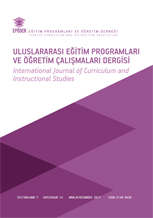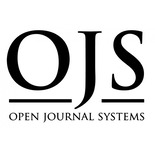A validity and reliability study on the self-regulated learning encouragement scale
Abstract
This study aimed to develop a scale to determine self regulated learning encouragement tendencies of teachers. In the scale, there are 41 items which were evaluated by external experts in terms of clarity, face validity and understandability. Then the scale was administered to 399 primary, secondary and high school teachers who were teaching in Erzurum to obtain validity and reliability results. In order to determine the construct validity of the scale, exploratory factor analysis was done. Then, confirmatory factor analysis was done to verify the factorial construction of the scale. In order to obtain reliability, internal consistency and split half reliability techniques were implemented. At the end of the exploratory factor analysis, a three factored construction containing 40 items were obtained. The compliance indexes were found to be ‘good’ at the end of the confirmatory factor analysis. The results of the reliability analysis also showed that the coefficient was found high.
Downloads
References
Buzza, D. & Allinotte, T. (2013). Pre-service teachers' self-regulated learning and their developing concepts of SRL. Brock Education: A Journal of Educational Research and Practice, 23(1), 58-76.
Cazan, A.M. (2013). Teaching self regulated learning strategies for psychology students.
Procedia-Social and Behavioral Sciences, 78, 743-747.
Çokluk, Ö., Şekercioğlu, G. ve Büyüköztürk, Ş. (2012). Sosyal bilimler için çok değişkenli istatistik SPSS ve LISREL uygulamaları (2. Baskı). Ankara: Pegem Yayıncılık.
Dignath, C., & Büttner, G. (2008). Components of fostering self-regulated learning among students. A meta-analysis on intervention studies at primary and secondary school level. Metacognition & Learning, 3, 231–264.
Dignath-van Ewijk, C. & Van der Werf, G. (2012). What teachers think about self- regulated learning: Investigating teacher beliefs and teacher behavior of enhancing students’ self-regulation. Education Research International, 1-10. doi: http://dx.doi.org/10.1155/2012/741713.
Dignath-van Ewijk, C., Dickhäuser, O. & Büttner, G. (2013). Assessing how teachers enhance self-regulated learning: A multiperspective approach. Journal of Cognitive Education and Psychology,12(3), 338-358.
Erkorkmaz, Ü., Etikan, İ., Demir, O., Özdamar, K., ve Sanisoğlu, S.Y. (2013). Doğrulayıcı faktör analizi ve uyum indeksleri. Türkiye Klinikleri Journal of Medical Sciences, 33(1), 210-223. doi. 10.5336/medsci.2011-26747.
Gordon, S. C., Dembo, M. H., & Hocevar, D. (2007). Do teachers’ own learning behaviors influence their classroom goal orientation and control ideology? Teaching and Teacher Education, 23, 36-46. doi: 10.1016/j.tate.2004.08.002.
Gündoğdu, K. (2006). A case study: Promoting self-regulated learnıng in early elementary grades. Kastamonu Eğitim Dergisi, 14,1, 47-60.
Hartwick, J. & Barki, H. (1994). Explaining the role of user participation in information system use. Management Science, 40(4), 440-465.
Jöreskog, K. & Sörbom, D. (1993). LISREL 8: Structural equation modeling with the SIMPLIS command language. Chicago, IL: Scientific Software International Inc.
Karteroliotis, K. (2008). Validation of a short form of the Greek version of the decisional balance scale in the exercise domain. Revista Internacional de Ciencias del Deporte. 11(4), 1-13.
Kim J., & Mueller, C. W. (1978). Introduction to factor analysis. Newbury Park, CA: Sage. Kline, R. B. (2005). Principles and practice of structural equation modeling (2nd Edition). NY:
Guilford Publications, Inc.
Laborda, J. G., Ozdamli, F., Maasoglu, Y., Peeters, J., De Backer, F., Reina, V. R., Kindekens, A., Buffel, T. & Lombaerts, K. (2014). 5th World Conference on Educational Sciences. The Role of Teachers’ Self-regulatory Capacities in the Implementation of Self-regulated Learning Practices. Procedia - Social and Behavioral Sciences, 116, 1963-1970. doi:http://dx.doi.org/10.1016/j.sbspro.2014.01.504.
Leiß, D. (2005). Teacher intervention versus self-regulated learning? Teaching Mathematics And Its Applications, 24 (2-3), 75-89. doi: 10.1093/teamat/hri020.
Lombaerts, K. Backer, F. D., Engels, N., Braak, J. & Athanasou, J. (2009). Development of the self-regulated learning teacher belief scale. European Journal of Psychology of Education, 24(1), 79-96.
Perry, N. E., Phillips, L., & Dowler, J. (2004). Examining features of tasks and their potential to promote self-regulated learning. Teachers College Record, 106, 1854- 1878.
Pintrich, P. R. (2000). The role orientation in self regulated learning. In Boekarts, M., Pintrich, P. R. and Zeidner, M. (Eds.). Handbook of Self Regulation. (pp. 452-502). San Diego and San Francisco: Academic Press.
Schunk, D. H., & Zimmerman, B. J. (Eds.). (2008). Motivation and self-regulated learning: theory, research, and applications. New York: Lawrence Erlbaum Associates.
Senemoğlu, N. (2010). Gelişim öğrenme ve öğretim kuramdan uygulamaya (18. Baskı).
Ankara: Pegem Akademi.
Spruce, R. and Bol, L. (2015). Teacher beliefs, knowledge, and practice of self-regulated learning. Metacognition Learning 10(2), 245- 277. doi:10.1007/s11409-014-9124-0.
Şimşek, Ö. F. (2007). Yapısal eşitlik modellemesine giriş: Temel ilkeler ve LISREL uygulamaları. Ankara: Ekinoks Yayıncılık.
Tabachnick, B.G. & Fidell, L.S., (2007). Using multivariate statistics. (5th ed.). Pearson Education, Inc. / Allyn and Bacon.
Tavşancıl, E. (2010). Tutumların ölçülmesi ve SPSS ile veri analizi (4. Baskı). Ankara: Nobel Yayın Dağıtım.
Tezbaşaran, A. A. (2008). Likert tipi ölçek hazırlama kılavuzu (3. Sürüm). http://www.academia.edu/1288035/Likert_Tipi_Olcek_Hazirlama_Kilavuzu adresinden 29.08.2016 adresinden alınmıştır.
Turan, S. (2009). Probleme dayalı öğrenmeye ilişkin tutumlar, öğrenme becerileri ve başarı arasındaki ilişkiler. (Yayımlanmamış doktora tezi). Hacettepe Üniversitesi Sosyal Bilimler Enstitüsü, Ankara.
Van Beek, J.A., de Jong, F.P.C.M., Minnaert, A.E.M.G., & Wubbels, T., (2014). Teacher practice in secondary vocational education: Between teacher-regulated activities of student learning and student self-regulation. Teaching and Teacher Education, 40, 1-9.
Zimmerman, B. J. (2002). Becoming a self-regulated learner: An overview. Theory into Practice, 41(2), 64-70. doi:10.1207/s15430421tip4102_2.





